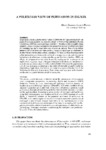Mostrar o rexistro simple do ítem
A politeness view of persuasion en ESL/EFL
| dc.contributor.author | García-Pastor, María Dolores | |
| dc.date.accessioned | 2011-07-13T11:42:42Z | |
| dc.date.available | 2011-07-13T11:42:42Z | |
| dc.date.issued | 2005 | |
| dc.identifier.citation | Lenguaje y textos, 2005, 23: 45-57. ISSN: 1133-4770 | es_ES |
| dc.identifier.issn | 1133-4770 | |
| dc.identifier.uri | http://hdl.handle.net/2183/8245 | |
| dc.description.abstract | [Resumen] El presente artículo intenta teorizar sobre el fenómeno de la persuasión desde un punto de vista pragmático, en concreto, desde la Teoría de la Cortesía de Brown y Levinson (1987) en conversaciones cotidianas llevadas a cabo en inglés como segunda lengua o lengua extranjera entre aprendices de ésta y hablantes nativos de la misma, los cuales mantienen una relación de amistad. Para ello se define primero qué se entiende por persuasión y cortesía al igual que se argumenta y se describe el vínculo entre ambos conceptos. En base a ciertas investigaciones sobre persuasión y cortesía en el campo de la pragmática y teniendo en cuenta la tipología de relaciones sociales establecida por Scollon y Scollon (1995), se ofrece una propuesta teórica sobre la posible realización de la persuasión en inglés como segunda lengua o lengua extranjera en la situación anteriormente descrita con un cierto grado de éxito, entendiéndose éste como la implementa- ción de este fenómeno comunicativo por parte del aprendiz de inglés según las expectativas lingüísticas, discursivas, relacionales y socio-culturales que dicho fenómeno implica en la lengua meta. Este trabajo concluye apuntando el carác- ter descriptivo y probabilístico de dicha propuesta. | es_ES |
| dc.description.abstract | [Abstract] The present article attempts to theorise about the phenomenon of persuasion from a pragmatic perspective, in particular, Brown and Levinson's (1987) Politenes s Theory, in daily conversational exchanges between learners of English as a secondlforeign language (ESUEFL), and native speakers of this language whom they are friends with. To this end, a definition of persuasion and politenes s is first offered, and the interrelation between both concepts is accoun- ted for and described. According to sorne studies of persuasion and politeness in the field of pragmatics, and Scollon and Scollon's (1995) typology of social dyads, a theoretical scheme on the potential enactment of persuasion in ESUEFL with certain degree of success in the aforementioned conversational exchanges is put forward. Success here refers to the implementation of this communicative phenomenon on the part of the learners in keeping with the lin- guistic, discursive, relational and socio-cultural expectations it entails in the tar- get language. This paper concludes underscoring the descriptive and probabilis- tic nature of this theoretical scheme. | es_ES |
| dc.language.iso | eng | es_ES |
| dc.publisher | Universidade da Coruña | es_ES |
| dc.title | A politeness view of persuasion en ESL/EFL | es_ES |
| dc.type | info:eu-repo/semantics/article | es_ES |
| dc.rights.access | info:eu-repo/semantics/openAccess |






